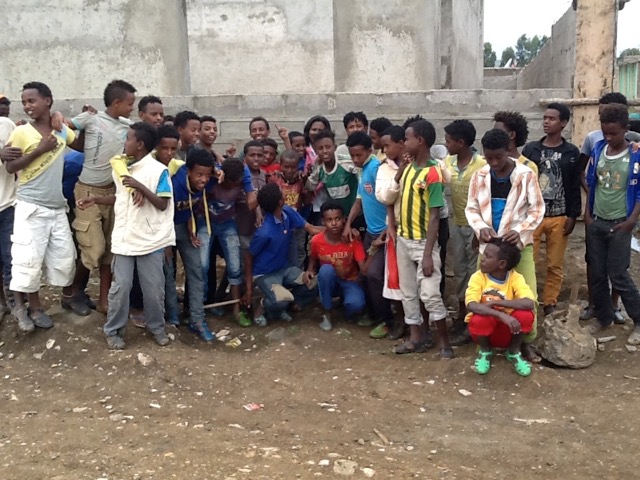International students studying in the US benefit from a community-based culture course focusing on social issues. Implications for college ESL programs are discussed.
Teaching culture as part of any curriculum leads to an enormous task of trying to represent the diversity of experience in the United States. Culture is amorphous, nebulous, contentious, and inextricable from language, as emphasized by the current standards recommended by the American Council of Teachers of Foreign Languages (ACTFL, 2013). Yet, the challenge of representing it in the curricula frequently leads textbooks and instructors to opt for “soft” topics covering products (e.g. popular songs, games, foods) and practices (e.g. ways of celebrating holidays, being polite), but not perspectives, i.e. attitudes, values, and ideas (ACTFL, 2013), thus, focusing, for example, on typical meals, celebrations, and hobbies. These approaches to teaching culture are easier, but the danger of reducing culture to Thanksgiving turkey and football is that students are left with a rather superficial understanding of U.S. culture, lacking specifically in the understanding of the current social issues. As Greenslate (2006) argues, the curriculum of language arts specifically is conducive to conversations about social justice and issues facing the society. We extended this argument to the college classes taught in Collegetown and redesigned the curriculum to expose the students to a variety of issues and help them connect with the local community.
Collegetown is a four-week English language and U.S. cultural immersion program held every summer at Concordia College in Moorhead, Minnesota. The program is populated primarily by students from United International College (UIC) in Zhuhai, China. Concordia College and Concordia Language Villages (CLV) partnered to create Collegetown, a hybrid of a tertiary-level EFL program and an experiential language immersion “village,” for which Concordia Language Villages is renowned. The CLV way holds meaningful play as a basic tenet of our pedagogy; CLV believes that intentional playfulness facilitates language learning (Concordia Language Villages, 2016). This approach is supported by a significant body of research showing that student enjoyment of activities is a predictor of learning retention through the connections between level of enjoyment and motivation (e.g. Busse & Walter, 2013) and that both instructors and students believe that language games contribute to language learning (Sobhani & Bagheri, 2014).
Challenges of Teaching Culture
In the initial years of our program, Collegetown had a marked dichotomy in the curriculum. Since the students received college credit for their time with us, we taught the morning ESL skills class in a more “traditional” way, focusing on reading about topics in U.S. culture, writing academic responses, and discussing the assigned readings, with the entire class being held in a formal classroom space. Conversely, in the afternoons and evenings, students did a variety of non-academic activities. However, based on our observations and conversations with students, the gap between essay outlining in the morning and a mock Halloween celebration in the afternoon lead the students to having a fragmented understanding of what life in the United States is like. While we were confident that our students were acquiring academic content in the classroom and language and interactional patterns from the recreational activities, the connection between the two curricular components was unclear, and we were unsure whether we were actually providing our international students with a representative experience of American life. This discrepancy was a matter of some concern for the Collegetown staff, and we were having discussions about improving the curriculum; however, the final push to create a new curricular model came from a revelation by one of the students several summers ago. Over lunch, a student was talking about the recession caused by the housing bubble of 2012 and said, “But all Americans have a house.” We were, quite frankly, embarrassed that after three and a half weeks in our program, this student still had such an enormous misconception about American life. We believed that our program had failed them if they went home to China with such an incomplete portrait of life in the United States.
Indeed, we consider it our moral and ethical obligation as teachers to disavow students of their erroneous assumptions of American culture, whether learned from the television and film, fragmented accounts of friends and relatives who have visited the U.S., or propaganda perpetuated by their own governments or ours. These assumptions were further reinforced by the students’ privileged position in the Chinese society, evidenced, for example, by their ability to attend a selective and expensive college. Trying to push the students to look beyond their own experiences led us to create a curriculum focused on social issues facing the United States, in the hope that it would help the student get a more complex understanding of the US culture and enable them to analyze other societies through a similarly critical lens.
Immersing Students in Community
Confronting and accepting one’s privilege and really considering social issues for the first time can be an extremely challenging endeavor. Thus, we designed the culture course to provide scaffolding for the students by giving them practical experiences and opportunities to explore the issues. One of the key approaches we used was developing community connections, i.e. trying to get the students to experience life in the community in a more authentic way through field trips, volunteering, and meeting with guest speakers. We also built connections within the program, so different components supported the main ideas. The culture class provided the overall framework for the program and identified the big issues we focused on, such as discrimination or access to healthy food, and the language classes and evening programs supported these topics. Even though it was not always possible to maintain close connections between all components, we tried to create sequences of activities for each segment of the program that would reinforce the critical concepts. For example, during one of the weeks the students discussed stereotypes and discrimination in the culture class, read and analyzed texts about gender in their language class, and participated in activities related to gender and society in the evenings. One night we held a mock wedding, in which students learned the traditions surrounding marriage and practiced using wedding-related vocabulary. While the students enjoyed the playfulness of the event, making dress gowns and creating the cut-out figures of bride and groom, it provided an excellent opportunity for us to discuss the contemporary changes to state and federal policies on same-sex marriage, as well as ways to talk respectfully about same-sex marriage, for example, why saying “Which one of you is the husband and which is the wife?” is insensitive and could be received badly.
Incorporating Critical Thinking and Academic Rigor
One of the major challenges in designing the new culture class was finding a way to combine academic rigor with the focus on community connections. Like students in other contexts, those coming to Collegetown already have ideas of what “studying” is and how it should be performed (Richardson, 1994). A typical academic English class at a U.S. college involves reading and writing academic papers with, perhaps, discussions and conversations. However, the culture class we were creating largely relied on being out in the community, which is a dramatic departure from what our students consider “academic.” Thus, we had to take additional steps to balance the activities both within each unit and the course as a whole.
Consequently, we tried to make sure that each unit involved three community connection components: a guest speaker, a field trip, and a volunteering project, as well as appropriate academic activities, such as analyzing articles, responding to discussion prompts, and completing vocabulary learning activities. Beyond this, we also tried to provide the students with cultural simulation activities, such as role-playing games. For example, for the unit on food, we invited a panel of three dining-services employees for an in-class discussion, visited an organic farm, and volunteered at a food pantry. We also watched the Food, Inc. documentary in class, analyzed food-related TV shows, and discussed cultural differences in food-related behavior and ideas about nutrition. The balance of activities within classroom and community exposed the students to a variety of perspectives and allowed them to experience multiple facets of U.S. food culture, while helping them practice critical thinking skills by relating different ideas to each other and understanding the connections between different phenomena, such as the link between the content of the documentary and challenges of creating healthy and appropriate meals that the dining services staff discussed.
Assessing Students
One of the biggest challenges we faced in designing the course was finding appropriate ways to assess students, as the move towards focusing on the deeper issues also meant moving away from more typical assignments to assigning a more significant proportion of grade to participation. Given that the program imperative was to provide the students with authentic materials and opportunities for engaging with the community, it was important that the assessments follow the same line of reasoning. The main venue of ongoing assessment was a classroom blog to which each student was asked to contribute two entries per week. The students could choose the topic of their postings, and we only asked that the entries be connected to the overall class themes and analysis of culture. Informal analysis of the entries shows that the students mostly used the blog to draw connections between their experiences in the US and in China, for example, comparing how families treat senior citizens or access to social services. The blog was particularly useful for the students who were less active in class, as it let them to “write through” their ideas and participate in class conversations. In addition to allowing us to monitor the students’ learning, the blog allowed the students to get acquainted with an important facet of American culture. While blogging is not a uniquely American phenomenon, it certainly occupies a significant space in the political and social discourses (O’Brien, 2004).
The participation component of the course was also assessed through in-class activities, which focused on showing the students multiple perspectives on controversial and relevant issues. The classroom activities also emphasized real-life situations and frequently included role-play or doing quick research on a topic. For example, when talking about lifestyles (work, wages, housing, food, work-family balance), the students had to create profiles of people in various circumstances and then find actual jobs that these people could apply for, housing they could afford, and transportation options. This led to conversations about budget, expenses, and prioritizing, concepts that used to be purely theoretical for some of our affluent students but came to life in these activities.
Asking students to complete these assignments created an imperative for them to use appropriate language, which then carried on to volunteering and field trips when the same units of language would come in useful in interactions. For example, the students read and discussed several articles about food issues, such as food deserts and shortage of healthy food options in poorer neighborhoods. The information helped them talk with the food pantry leaders and clients, since they were familiar with the major discourses and had a basic understanding of the food-related issues facing the community.
Addressing Controversial Social Topics
Focusing the class on social issues brought about the challenge of acknowledging the instructors’ and staff views and accounting for them. For example, staff members had different opinions on the United States Supreme Court ruling on the constitutionality of same-sex marriage, and class discussions included the difference of opinions along with explanations and rationales. The instructors started by setting expectations for discussing difficult subjects (for example, trying to understand where a person was coming from and what influenced their beliefs). We framed the discussion by explaining the different opinions on the issue and the attitudes behind them. The acceptance of different viewpoints in these classes helped set the tone of cultural exploration for the rest of the class. The unit on religion and education presented another challenge as one instructor was an atheist. This was also discussed in class, during a general conversation about religion and differences among religious views of the students. The most challenging aspect of this was finding the balance between creating a space where all students and instructors felt comfortable sharing their opinions, while also showing how different opinions connected to the social issues. We cannot say that we were absolutely successful in this process, but the students felt comfortable enough to discuss these topics, expressing both agreement and disagreement with the various aspects of the issues.
The experience of designing a culture class curriculum focused on social issues proved beneficial for the Collegetown students and could be extended to other contexts. While many colleges and universities (liberal arts or otherwise) in the United States have freshmen-level, topic-based research and writing inquiry seminars that require students to get out into the community and apply their learning to some pragmatic end, relatively few university-level ESL programs offer such courses. Most college ESL programs push language acquisition and mastery — but language and culture are intertwined! This class presents a model for combining ESL language course with exploration of culture and community service, providing the students with a more authentic experience and giving them multiple real-life language practice opportunities.
A quality liberal arts education targets the entire person, cognitively, spiritually, socially, and physically. Concordia College and United International College share the vision of a tertiary education that does more than intellectual development. That vision frames the Collegetown program, as it also frames Concordia Language Villages. Developing a community-based culture course helped Collegetown realize that vision, and while the program faced some challenges, Implement
ing this curriculum improved the experience for the students, allowing them to develop a more comprehensive understanding of American culture that included awareness of social issues and a higher level of engagement with the local community.
References
ACTFL. (2013). Program standards for the preparation of foreign language teachers. Retrieved from http://www.actfl.org/sites/default/files/pdfs/ACTFLProgramStandardsProposal.pdf
Busse, V. and Walter, C. (2013). Foreign language learning motivation in Higher Education: A longitudinal study of motivational changes and their causes. Modern Language Journal, (97), 435–456.
Concordia Language Villages. (2016). The CLV way. Retrieved from http://www.concordialanguagevillages.org/youth-languages/our-teaching-methods/clvway
Greenslate, C. (Winter 2006). Social justice and language arts. Green Teacher, (80), 28-32.
Kop, R., & Hill, A. (2008). Connectivism: Learning theory of the future or vestige of the past? International Review of Research in Open & Distance Learning, 9(3).
O’Brien, B. (2004). Blogging America: Political discourse in a digital nation. Franklin, Beedle & Associates, Inc.
Richardson, J. (1994). “Cultural specificity of approaches to studying in Higher Education: A literature survey.” Higher Education 27(4), 449-68.
Sobhani, M., & Bagheri, M. S. (May 2014). Attitudes toward the Effectiveness of communicative and educational language games and fun activities in teaching and learning English. Theory & Practice In Language Studies, 4(5), 1066-1073.
Acknowledgements: curriculum redesign was made possible through the efforts of all Collegetown instructors and staff, namely Rosanna Willhite, Katie Olson, Vasyl Babiy, Marie Wojcik, Lisa Rinehart, and Philip Erickson.






